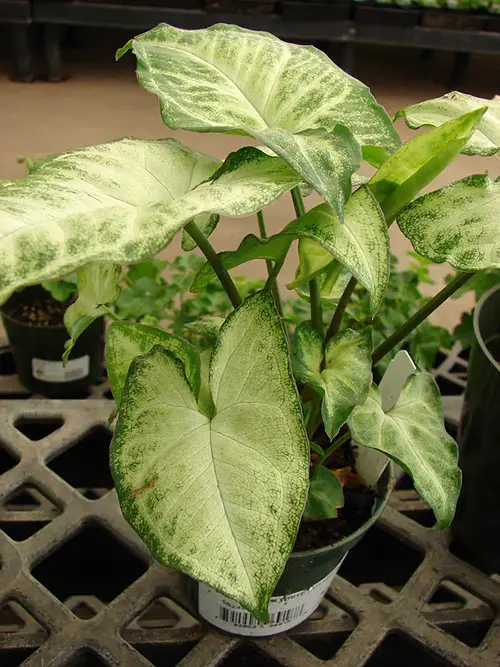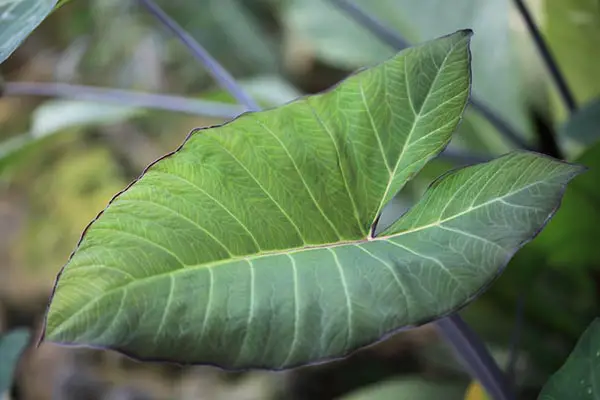The dense foliage of this wonderful plant makes a gorgeous addition to any home. But how to care for this beauty and keep her healthy? Read on if you’d like to know how to take care of your arrowhead plant.

What is an Arrowhead Plant?
Arrowhead plant (Syngonium podophyllum) is known by many names – arrowhead vine, arrowhead philodendron, goosefoot, five fingers, American evergreen or African evergreen. It is also known by its former name Nephthytis podophyllum.
This easy-care houseplant is a vigorous climber – it has vining (or creeping) growth habit so it’s a perfect plant for a hanging basket or against a trellis or other kinds of support. It can be also used as a groundcover or in a combination with other ornamental plants to give interest.
However, if you prefer a more compact appearance, you can control its creeping nature by pinching, pruning or cutting the climbing stems as they develop. You can also buy selected varieties with more compact and bushier appearance with less climbing.
The plant has got its name from the shape of its leaves. In the beginning, the leaves have an arrowhead or heart shape. As the plant matures, the leaves became palmate – they change their shape into three to five finger-like sections. Hence the name ‘five fingers’.
Arrowhead plant is native to Latin America but it’s neutralized in Florida, Texas, Hawaii, etc. It is usually grown indoors, but if you live in warm regions you can grow it outdoors. Just be aware of its invasive nature – the plant easily becomes invasive in warm, humid regions like Florida, where the plant is declared to be Category 1 Invasive species.
An arrowhead plant is easily bought online and may be also found at your local nursery.
How to Take Care of Your Arrowhead Plant
Arrowhead plant is a low-maintenance houseplant, but only if given the right growing conditions:
- Light requirements: Depending on the leaf variegation, the plant will need a sunny, bright spot or shadier one. The heavily variegated cultivars prefer bright light, while those with solid green leaves, darker foliage or less variegation love moderate light. Keep the plant out of direct sunlight to avoid sunburns.
- Temperature requirements: The best growing conditions for the arrowhead plant are 60-75 ºF (15-24 ºC). It can tolerate 50 ºF (10 ºC), but anything below may kill the plant. Arrowhead plant grows best in warm conditions and it grows on a slower pace during winter months. Keep your arrowhead plant from sudden temperature drifts.
- Water requirements: Water your arrowhead plant regularly, but let soil dries out between waterings. To avoid root rot, don’t let the plant sits in the water. Being native to tropical rainforests, the plant needs humid air conditions, especially during winter months, so you should moisten the foliage daily. Another option is a large container with a constantly moist peat.
- Soil requirements: The arrowhead plant doesn’t have any special soil requirements. Any decent soil with good drainage and a bit of compost will do well. You can fertilize the plant once a year, during the summer or the spring, but it’s not necessary.
- Propagation: Arrowhead plant is propagated through cuttings, divisions or air layering. Propagate the plant in the spring or the summer.
- Toxicity: The plant is considered to be mildly toxic to pets, so keep your plant away from dogs and cats. Its sap can cause skin irritation in humans, so be sure to always wear gloves when working with the plant. When ingested it causes painful swelling of lips and tongue so as gastric distress, nausea, or vomiting.

Common Problems with Arrowhead Plant
Arrowhead plant can face several problems. Most of them occur due to inadequate care. Another type of problem is related to pests that are attracted to its dense foliage. Here are some of the most common problems with the arrowhead plant:
- Yellowing leaves: This is probably a symptom of too much or too little water. Check the soil if it’s too wet or too dry. When you identify the cause, do the opposite. Remove yellow leaves off the plant.
- Lack of growth: It is normal for arrowhead plant to grow slower during winter months, but if the problem appears during the growing season, it could be related to under or overwatering. It can be also related to poor soil that lacks nutrients.
- Brown leaf tips: The cause is probably dry air. Moisten the foliage daily.
- Pests: Arrowhead plant is susceptible to aphids, mealybugs, and spider mites. Check for these pests inside the foliage where they usually appear.
If you maintain a regular watering schedule and provide your Arrowhead plant with adequate light conditions, you will have an interesting and attractive houseplant that grows enthusiastically with minimal care.